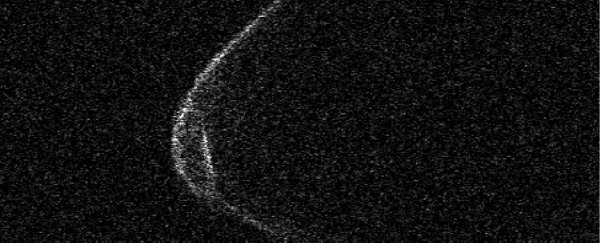There's an asteroid closing in on a safe Earth flyby. That's nothing unusual - near-Earth space has a lot of rocks in it. But 1998 OR2 is distinguishing itself in a series of happy snaps as it draws closer to periapsis.
Both the Virtual Telescope Project in Rome and the Arecibo Observatory in Puerto Rico have managed to catch glimpses of the asteroid as it grows brighter in our skies, travelling through space at around 31,320 kilometres per hour (19,461 miles per hour).
We have nothing to fear from 1998 OR2. It's relatively large, but it's not going to come close enough to threaten Earth. The asteroid was discovered in 1998, and astronomers have been watching it carefully to calculate its orbital path, which is projected all the way until the year 2197.
This year, 2020, will mark the asteroid's closest flyby in at least a century, and it's going to sail harmlessly past at a distance of 6.3 million kilometres (around 4 million miles). That's over 16 times the average distance between Earth and the Moon.
#TeamRadar and the @NAICobservatory staff are taking the proper safety measures as we continue observations. This week we have been observing near-Earth asteroid 1998 OR2, which looks like it's wearing a mask! It's at least 1.5 km across and is passing 16 lunar distances away! pic.twitter.com/X2mQJCT2Qg
— Arecibo Radar (@AreciboRadar) April 18, 2020
But because it's so large - estimates put it at around 4.1 kilometres long and 1.8 kilometres wide (2.5 by 1.1 miles) - it's unusually bright. It's therefore one of the largest and brightest near-Earth asteroids, and when it flies by on April 29 - periapsis, or its closest orbit, will be around 09:56 GMT - amateur astronomers may even be able to see it with smaller telescopes.
It is classed as a 'potentially hazardous' asteroid, because all asteroids above a certain size (140 metres) and within a certain distance of Earth (7,480,000 kilometres or 4,650,000 miles) are automatically classified as such.
But projections for 1998 OR2 don't indicate any kind of collision in our future. The next time it will come close to Earth will be in 2079, when it will swing by at a distance of 1.8 million kilometres (1.1 million miles). That's around 4.6 times the lunar distance.
Enjoy this super video, showing potentially hazardous #asteroid #1998OR2 moving across the stars, preparing for its SAFE flyby next 29 April. @BadAstronomer @AsteroidDay @PopSci @earthskyscience @universetoday @SkyandTelescope
— Virtual Telescope (@VirtualTelescop) April 17, 2020
Full res version: https://t.co/OHKUvGhH4f pic.twitter.com/p1T2hUuI9Q
In fact, this flyby is really cool. It will allow astronomers to take measurements of the asteroid so we can refine our size estimation techniques. We can also study the asteroid itself, to learn more about the composition of these space rocks. And tracking these objects also helps us develop measures for defending Earth against asteroids that could be genuinely hazardous.
If you want to try to catch a glimpse of this awesome chunk of rock, EarthSky has detailed instructions on the equipment you will need, and where in the sky to look.
If you are in the wrong place, or don't have a telescope, though, never fear - the Virtual Telescope Project will be livestreaming the event on its website.
